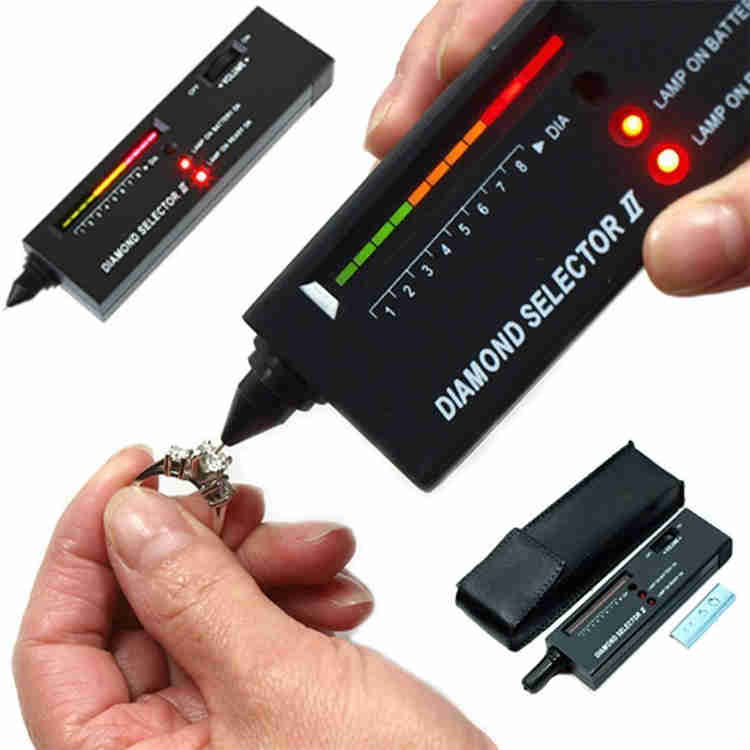
What is a diamond tester pen?
Diamond tester pens are small devices used by jewelers to differentiate between diamonds and other gemstones. Most gemstones look noticeably different than diamonds. But, when it comes to diamond simulants like moissanite, cubic zircon, or even synthetic diamonds, It is challenging to notice the difference. Hence the diamond tester pen is to identify diamond look-alikes.
The testers work by measuring either the thermal or electrical conductivity of stones. The thermal conductivity testers were quite popular until the introduction of moissanite in the market. The thermal testers incorrectly identified moissanite as diamonds because they have similar thermal conductivity as diamonds.
Several companies introduced electrical testers to keep up with this advancement in technology. Electrical testers are good at identifying moissanite since they are more conductive than diamonds. Apart from diamonds, these tester pens can also identify rubies, emeralds, and other precious and semi-precious stones.
Since then, because the electrical conductivity testers could correctly identify moissanite, they were cheap and portable. They have gained popularity with jewelry retailers, wholesalers & manufacturers.
Can they be used to identify lab-grown diamonds?
Lab-grown diamonds grow in machines and natural diamonds in the earth’s crust. Except for this, they are physically & chemically the same, meaning they should have the same electrical conductivity as natural diamonds.
Hence electrically, conductivity tests should not be able to differentiate between lab-grown and natural diamonds. However, in reality, many jewelers do the pen to identify lab-grown diamonds. Because the tester pen identifies diamonds grown using HPHT technology as moissanite, why is it so? If lab-grown diamonds are the supposedly same as natural diamonds.
Lab-grown diamonds are grown using two different technologies chemical vapor deposition (CVD) & high-pressure high-temperature (HPHT). While the pen identifies HPHT stones as moissanite, the CVD diamonds pass the test. Since the test measures the electrical conductivity of stone and the tester are calibrated to identify stones based on their conductivity rating. However, the electrical conductivity of diamonds is not a fixed number. It is a range that varies due to the nature of inclusions in them. HPHT diamonds’ conductivity is high enough for them to be falsely identified as moissanite by the testing pens. What makes HPHT diamonds more conductive than their natural or CVD counterparts?
It is the catalyst used to grown the stones. The catalyst contains iron, cobalt, and other elements. During the growth process, some of these metals precipitate into the crystal in the form of inclusions. These metallic inclusions alter the conductivity of HPHT diamonds and make them easy to spot using a pen-tester.
Though a tiny percentage, some unscrupulous actors in the industry use the testing pen’s ability to differentiate HPHT-grown stones to cheat the consumers. By demonstrating that these pens are a reliable way to test for lab-grown diamonds. They then pass off CVD diamonds, which pass the test to sell them as natural diamonds. With the advancements in technology, there is also now low conductivity moissanite available with an electrical conductivity similar to diamonds and passes the electrical conductivity test. Some actors also sell this moissanite as a natural diamond.
What is a reliable way to test for a lab-grown stone?
Though not a hundred percent, the only reliable way to identity lab-grown diamonds. Whether they are CVD or HPHT is using short wave fluorescence. There is a possibility that this might identity some natural diamonds as lab-grown. Still, it is limited to a relatively small percentage of natural diamonds. Hence, it is considered a reliable method of testing.
The short wave fluorescence devices, which were expensive & cumbersome, are now much cheaper & easy to use. To stop unscrupulous actors from taking advantage of a lack of education amongst industry & consumers. Both natural and lab-grown diamond industries should push for the adoption of these devices across the supply chain. Especially at the retail level, to instill consumer confidence to the benefit of both sectors.
